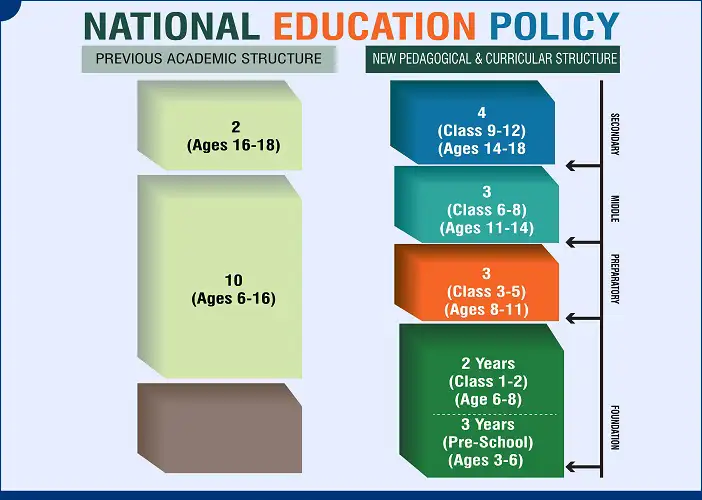New Education Policy
Something we all parents have been hearing from the past few years… What exactly is this? Even if you have downloaded your copy from the internet, the number of pages gives all of us jitters ! Don’t worry; we have made your life easier.
In this blog post, we’ll explore everything you need to know about the New Education Policy and why it matters for students, teachers, parents, and all those invested in creating a brighter future for India through education. So let’s dive in!
First, we’ll see: What is the New Education Policy 2023?
In terms of India’s education system, there is no other way to describe the New National Education Policy 2023 than as revolutionary. The Ministry of Education announced major changes to our education policy in July 2020, some three decades later, with the sole goal of revolutionizing how we learn and teach. “Educate, Encourage, and Enlighten” is the mantra for the NEP.
The Indian government started this project so that students could learn skills for the 21st century. Compared to the old policy, the changes made by NEP focus on three things: Research, Innovation, and Quality. The government is willing to spend a lot to make sure this education policy works well.
The government introduced a switch to the 5+3+3+4 model (pre-school to class 2, class 3 to 5, class 6 to 8, and class 9 to 12) from the 10+2 structure, which is classified into Foundation Stage, Preparatory Stage, Middle Stage, and Secondary Stage.
- The Foundation Stage starts from ages three to eight and will focus on multi-level play, interactive school activities, and basic literacy and numeracy instruction.
- The Preparatory Stage starts at age eight and lasts until age eleven. Classes 3–5 fall into this category. It will focus on all the subjects and activities that will lay the foundation.
- The Middle stage starts from ages 11 to fourteen, and students in grades six to eight fall into this category. This approach will focus on the practical uses of arts, social activities, humanities, science, and mathematics with internships to provide real life exposures to the working environment.
- And the last stage, which is Secondary Level, starts from ages fourteen to eighteen, and will be focusing on multidisciplinary learning, critical thinking, and analysis, as well as the importance of student voice and subject matter mastery.
What are the key features of the New Education Policy?
The key features of the New Education Policy are as follows:
- The National Curriculum Framework (NCF) will be regularly updated.
- Life skills like critical thinking and creativity will be the main focus of school.
- The importance of the skills and strategies that involve reading, speaking, writing, and interpreting thoughts, as well as basic numeracy skills like addition, subtraction, multiplication, and division, will increase in Early Literacy.
- Arts, science, academic, vocational, curricular, and extracurricular subject streams will not differ from each other.
- Students can appear for the board exams twice.
- India’s literature and other classical languages will be included in the school curriculum.
Are there any limitations to the New Education Policy?
❖ The policy gives too much importance to vocational and technical education, where students from poor backgrounds end up in lower quality vocational schools while those from rich families go to private schools with better resources.
❖ The policy didn’t address the needs of students with special educational needs. There is no mention made of schooling that is inclusive of children who are disabled.
The New Education Policy does not do enough to address the systemic problems facing India’s education system. Even though it has positive measures, like increasing the budget for education and making it easier for young children to get care, it isn’t enough to fix the problems that have been going on for a long time in Indian education.
IN SUMMARY
The National Education Policy 2023 is a much-needed, all-encompassing reform that aims to make the Indian education system more open, flexible, and learner-centered. The new policy is designed to address the issues and gaps in the education system and give everyone, no matter where they come from financially, a good education.
The policy calls for an approach to education that is whole and integrated, with a focus on developing skills, learning from different fields, and encouraging creativity and critical thinking. It also stresses the importance of using technology and digital resources to improve learning.
The government, educational institutions, teachers, students, and parents, as well as the business sector, will all need to work together and help to put the new policy into action.
Also Read: 5 Things to Remember When Choosing the Best Schools in Bangalore



